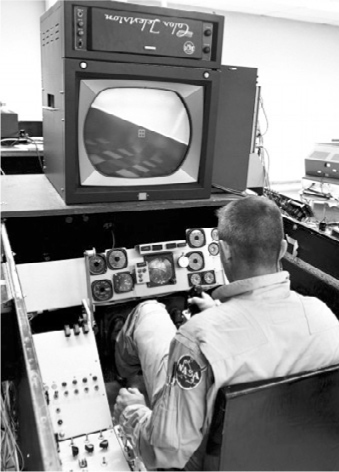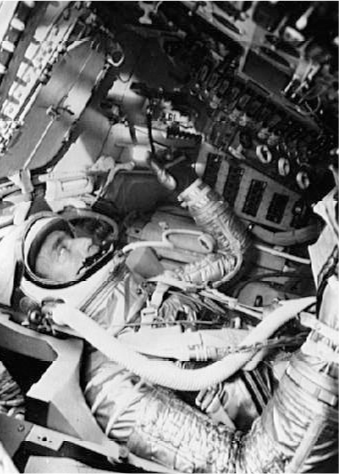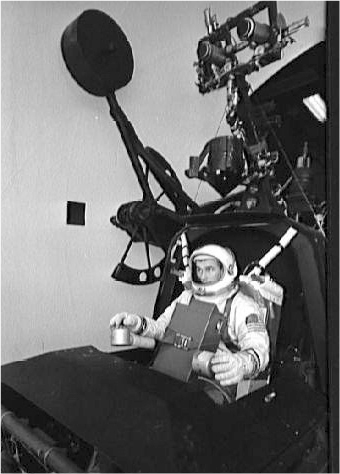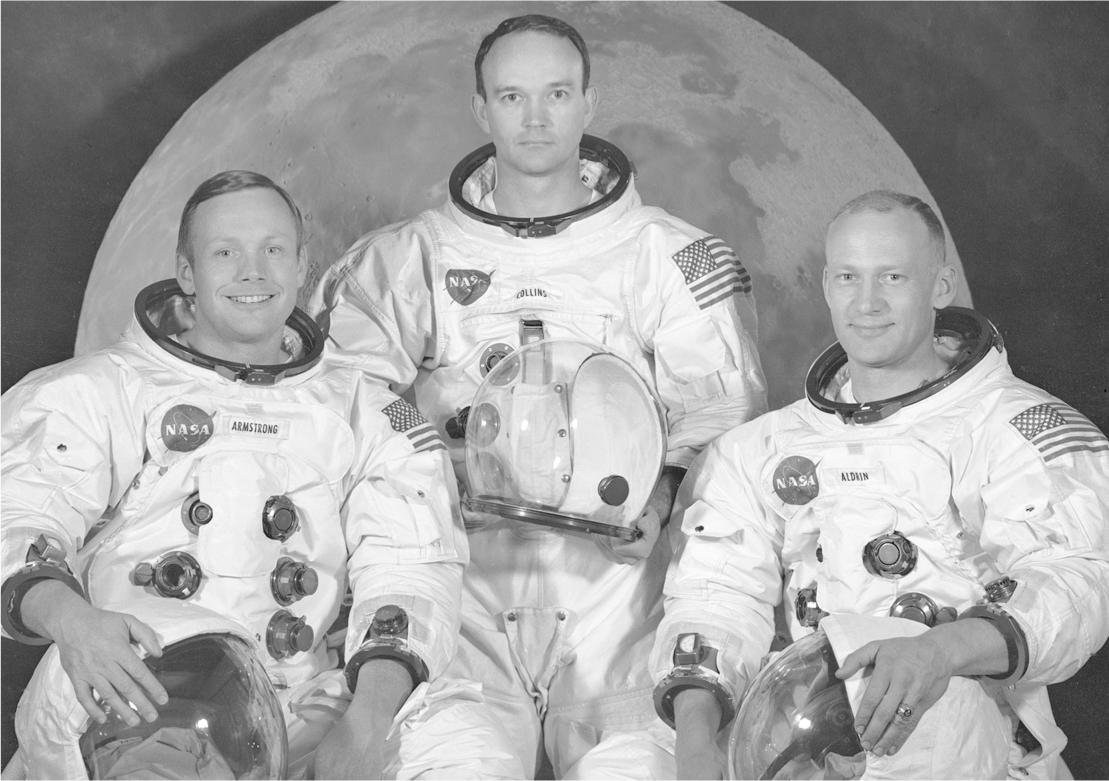In Australia a team from the Postmaster-General’s Department worked literally day and night installing a TV link through the tree-covered mountains between Honeysuckle Creek and Canberra, so that the pictures we received from the Moon could be televised to the world.
In the United States the astronauts had spent over 400 hours in space-flight simulators. These large training machines simulated the conditions likely to be experienced by the astronauts in space. The interior of each simulator was an exact replica of the spacecraft, allowing the astronauts to work the controls and practise manoeuvres as they would in space.
Initially, Buzz Aldrin was chosen to be the first man to walk on the Moon, but when they did their first practice the astronauts realised that Aldrin would have to climb over Armstrong in his bulky spacesuit to get to the hatch. So Neil Armstrong would be the first man to set foot on the surface of the Moon. During this period the Soviets were also trying to land a man on the Moon. Would they get to the Moon first?

This early simulator was used for both training and determining a given vehicle’s handling at various speeds, attitudes and altitudes. This provided warning of possible problems.
NASA

Astronaut training in Aerospace Flight Simulator.
NASA

A prime pilot astronaut undergoing a simulated mission in the procedures trainer.
NASA
In January, two Soviet crews transferred from one spacecraft to another while in space — the first time this had ever been done. On 21 February 1969, the Soviets launched an unmanned spacecraft on the most massive rocket ever built. It was as tall as a 37-storey building.
The launch went perfectly. The giant spacecraft rose in the sky — for 60 seconds. Suddenly vibrations inside the rocket broke a fuel line. Cold liquid oxygen poured into the spacecraft, turning the burning rocket fuel into a gigantic bomb.
When the Soviet technicians on Earth realised that there was a fire on board they shut down the motors, but it was too late. Fire burst across the sky. Burning debris showered an area of a 40-kilometre radius.
This incident meant that the Soviets could not land an astronaut on the Moon before the Americans. But it deepened the fear that haunted all of us in the space program: what if something goes wrong?
Mission Commander
Neil A. Armstrong, civilian
Born 5 August 1930, Wapakoneta, Ohio. Married, two children. (His third daughter had died.)
BSc in aeronautical engineering, Purdue University, 1955. MSc in aerospace engineering, University of Southern California, 1970.
Armstrong had already showed extraordinary heroism when during the first practice manual docking manoeuvre, the spacecraft went into an uncontrolled spin until Armstrong managed to gain control and made an emergency landing in the Pacific Ocean.
Space flights: Command pilot, Gemini 8 (1966). Commander, Apollo 11 (1969).
After Apollo 11 Armstrong stayed a private, modest and dedicated man, speaking only at charity events or those he had a special connection to. He became Deputy Associate Administrator for Aeronautics at NASA, then Professor of Aerospace Engineering at the University of Cincinnati. He served on the National Commission on Space from 1985 to 1986 and on the Presidential Commission on the Space Shuttle Challenger Accident in 1986. He was granted the Congressional Gold Medal in 2009 among decorations in 17 countries. He died on 25 August 2012, at 82. He was given a full military naval funeral at sea with all possible honours.
Command Module Pilot
Michael Collins, Lieutenant Colonel, United States Air Force Born 31 October 1930, Rome, Italy. Married, three children.
BSc, US Military Academy, 1952.
Space flights: Pilot, Gemini 10 (1966). Command module pilot, Apollo 11 (1969).
After Apollo 11 Collins resigned from NASA in January 1970 and was appointed Assistant Secretary of State for Public Affairs. He became Director of the National Air and Space Museum at the Smithsonian Institution in April 1971 and was promoted to Undersecretary of the Smithsonian in April 1978. Collins retired from the Air Force with the rank of Major General. He became Vice-President, Field Operations, Vought Corporation in Arlington, Virginia, in February 1980, and later Michael Collins Associates, a consulting firm in Washington DC. Michael Collins has written many articles and three books: Carrying the Fire, Liftoff and Flying to the Moon and Other Strange Places. He and the other two members of the Apollo 11 crew were presented with the Smithsonian Institute’s Langley Gold Medal for Aerodromics in 1999 and the Congressional Gold Medal in 2009. The asteroid 6471 Collins is named after him.

Apollo 11 crew: Neil A. Armstrong, Michael Collins and Edwin E. Aldrin Jr.
NASA
Lunar Module Pilot
Buzz Aldrin, Colonel, United States Air Force
Born Edwin Eugene Aldrin, Jr., 20 January 1930, Montclair, New Jersey. Later, legally changed his name to ‘Buzz Aldrin’. Married, three children.
BSc, US Military Academy, 1951. PhD in astronautics, Massachusetts Institute of Technology, 1963.
Space flights: Pilot, Gemini 12 (1966). Lunar module pilot, Apollo 11 (1969).
After Apollo 11 Aldrin resigned from NASA in July 1971 and became Commandant of the Aerospace Research Pilot School at Edwards Air Force Base in California. He retired from the Air Force in 1972 and became a consultant for the Comprehensive Care Corporation in Newport Beach, California. He lectured and consulted on space sciences with StarCraft Enterprises and wrote two books: Return to Earth and Men From Earth.
He is the ‘celebratory astronaut’ of the crew, giving many public lectures. He once physically defended himself and his daughter from a ‘moon landing conspiracist’ who demanded that Aldrin swear on the Bible that the moon landings weren’t faked.
A comment he made about seeing an unidentified flying object — a detached panel from the Saturn V rocket — was edited to make it seem as if he claimed to have seen a ‘real’ U.F.O. Aldrin demanded a retraction. He has appeared in many movie and TV roles and is active in politics. The Aldrin crater near the Apollo 11 landing site is named after him.